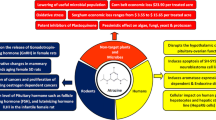Abstract
Bioaerosols are an important subgroup of atmospheric aerosols, and microorganisms are a major component of bioaerosols. Microbial activity can affect climate change, human health and environmental processes. We developed a diacetate (FDA) hydrolysis method to measure microbial activity in bioaerosols. A large number of preliminary experiments were used to optimise the experimental conditions and guarantee the applicability of this assay to environmental bioaerosol samples. The level of microbial activity in the atmosphere in the Qingdao coastal region was measured using the FDA method in May and from September to December 2012. The microbial activity in bioaerosols varied from 10.7 to 85.8 ng/m3 sodium fluorescein, with an average of 30.2 ng/m3. The microbial activity in bioaerosols displayed monthly variations, with the highest value in May. However, the activity showed no significant correlation with temperature, relative humidity and wind speed. Thus, further study is needed to elucidate the major factors and mechanisms that affect microbial activity in the atmosphere.









Similar content being viewed by others
References
Abdel-Hameed, A. A., Khoder, M. I., Yuosra, S., Osman, A. M., & Ghanem, S. (2009). Diurnal distribution of airborne bacteria and fungi in the atmosphere of Helwan area, Egypt. Science of the Total Environment, 407(24), 6217–6222.
Adam, G., & Duncan, H. (2001). Development of a sensitive and rapid method for the measurement of total microbial activity using fluorescein diacetate (FDA) in a range of soils. Soil Biology & Biochemistry, 33(7), 943–951.
Amato, P., Demeer, F., Melaouhi, A., Fontanella, S., Martin-Biesse, A. S., Sancelme, M., et al. (2007a). A fate for organic acids, formaldehyde and methanol in cloud water: their biotransformation by micro-organisms. Atmospheric Chemistry and Physics, 7(15), 4159–4169.
Amato, P., Parazols, M., Sancelme, M., Laj, P., Mailhot, G., & Delort, A. M. (2007b). Microorganisms isolated from the water phase of tropospheric clouds at the Puy de Dome: Major groups and growth abilities at low temperatures. FEMS Microbiology Ecology, 59(2), 242–254.
Battin, T. J. (1997). Assessment of fluorescein diacetate hydrolysis as a measure of total esterase activity in natural stream sediment biofilms. Science of the Total Environment, 198(1), 51–60.
Bauer, H., Giebl, H., Hitzenberger, R., Kasper-Giebl, A., Reischl, G., Zibuschka, F., et al. (2003). Airborne bacteria as cloud condensation nuclei. Journal of Geophysical Research, 108(D21), 4658.
Bjurman, J. (1993). Determination of microbial activity in molded wood by the use of fluorescein diacetate. Material Und Organismen, 28(1), 1–16.
Bowers, R. M., Lauber, C. L., Wiedinmyer, C., Hamady, M., Hallar, A. G., Fall, R., et al. (2009). Characterization of airborne microbial communities at a high-elevation site and their potential to act as atmospheric ice nuclei. Applied and Environmental Microbiology, 75(15), 5121–5130.
Bowers, R. M., McCubbin, I. B., Hallar, A. G., & Fierer, N. (2012). Seasonal variability in airborne bacterial communities at a high-elevation site. Atmospheric Environment, 50, 41–49.
Bowers, R. M., McLetchie, S., Knight, R., & Fierer, N. (2011). Spatial variability in airborne bacterial communities across land-use types and their relationship to the bacterial communities of potential source environments. The ISME Journal, 5(4), 601–612.
Breeuwer, P., Drocourt, J. L., Bunschoten, N., Zwietering, M. H., Rombouts, F. M., & Abee, T. (1995). Characterization of uptake and hydrolysis of fluorescein diacetate and carboxyfluorescein diacetate by intracellular esterases in Saccharomyces cerevisiae, which result in accumulation of fluorescent product. Applied and Environmental Microbiology, 61(4), 1614–1619.
Chen, Y. J. (2005). Sample and detect airborne microorganisms by composite membrane filtration method. Environmental Monitoring in China, 21(4), 14–17.
Dales, R. E., Cakmak, S., Judek, S., Dann, T., Coates, F., Brook, J. R., et al. (2004). Influence of outdoor aeroallergens on hospitalization for asthma in Canada. Journal of Allergy and Clinical Immunology, 113(2), 303–306.
Delort, A. M., Vaïtilingom, M., Amato, P., Sancelme, M., Parazols, M., Mailhot, G., et al. (2010). A short overview of the microbial population in clouds: Potential roles in atmospheric chemistry and nucleation processes. Atmospheric Research, 98(2–4), 249–260.
Deng, S. P., & Tabatabai, M. A. (1994). Colorimetric determination of reducing sugars in soils. Soil Biology & Biochemistry, 26(4), 473–477.
Fang, Z. G., Ouyang, Z. Y., Hu, L. F., Wang, X. K., & Miao, H. (2004). Progresses of airborne microbial communities in urban ecosystem. Acta Ecologica Sinica, 24(2), 315–322.
Fang, Z. G., Ouyang, Z. Y., Zheng, H., Wang, X. K., & Hu, L. F. (2007). Culturable airborne bacteria in outdoor environments in Beijing, China. Microbial Ecology, 54(3), 487–496.
Fontvieille, D. A., Outaguerouine, A., & Thevenot, D. R. (1992). Fluorescein diacetate hydrolysis as a measure of microbial activity in aquatic systems: Application to activated sludges. Environmental Technology, 13(6), 531–540.
Fuzzi, S., Mandrioli, P., & Perfetto, A. (1997). Fog droplets—An atmospheric source of secondary biological aerosol particles. Atmospheric Environment, 31(2), 287–290.
Green, V. S., Stott, D. E., & Diack, M. (2006). Assay for fluorescein diacetate hydrolytic activity: Optimization for soil samples. Soil Biology & Biochemistry, 38(4), 693–701.
Griffin, D. W., Kubilay, N., Koçak, M., Gray, M. A., Borden, T. C., & Shinn, E. A. (2007). Airborne desert dust and aeromicrobiology over the Turkish Mediterranean coastline. Atmospheric Environment, 41(19), 4050–4062.
Griffiths, W., & DeCosemo, G. (1994). The assessment of bioaerosols: A critical review. Journal of Aerosol Science, 25(8), 1425–1458.
Guilbault, G. G., & Kramer, D. N. (1964). Fluorometric determination of lipase, acylase, alpha-, and gamma-chymotrypsin and inhibitors of these enzymes. Analytical Chemistry, 36(2), 409–412.
Gumprecht, R., Gerlach, H., & Nehrkorn, A. (1995). FDA hydrolysis and resazurin reduction as a measure of microbial activity in sediments from the south-east Atlantic. Helgoländer Meeresuntersuchungen, 49(1–4), 189–199.
Hara, K., & Zhang, D. Z. (2012). Bacterial abundance and viability in long-range transported dust. Atmospheric Environment, 47, 20–25.
Hill, K. A., Shepson, P. B., Galbavy, E. S., Anastasio, C., Kourtev, P. S., Konopka, A., et al. (2007). Processing of atmospheric nitrogen by clouds above a forest environment. Journal of Geophysical Research, 112(D11301), 1–16.
Hua, N. P., Kobayashi, F., Iwasaka, Y., Shi, G. Y., & Naganuma, T. (2007). Detailed identification of desert-originated bacteria carried by Asian dust storms to Japan. Aerobiologia, 23(4), 291–298.
Jeon, E. M., Kim, H. J., Jung, K., Kim, J. H., Kim, M. Y., Kim, Y. P., et al. (2011). Impact of Asian dust events on airborne bacterial community assessed by molecular analyses. Atmospheric Environment, 45(25), 4313–4321.
Kim, K. Y., & Kim, C. N. (2007). Airborne microbiological characteristics in public buildings of Korea. Building and Environment, 42(5), 2188–2196.
Kourtev, P. S., Hill, K. A., Shepson, P. B., & Konopka, A. (2011). Atmospheric cloud water contains a diverse bacterial community. Atmospheric Environment, 45(30), 5399–5405.
Li, M., Qi, J., Zhang, H., Huang, S., Li, L., & Gao, D. (2011). Concentration and size distribution of bioaerosols in an outdoor environment in the Qingdao coastal region. Science of the Total Environment, 409(19), 3812–3819.
Liao, C. M., & Luo, W. C. (2005). Use of temporal/seasonal- and size-dependent bioaerosol data to characterize the contribution of outdoor fungi to residential exposures. Science of the Total Environment, 347(1–3), 78–97.
Maier, R. M., Pepper, I. L., & Gerba, C. P. (2010). Environmental microbiology. Beijing, China: Science Press.
Mandrioli, P. (1998). Basic aerobiology. Aerobiologia, 14(2–3), 89–94.
Matthias-Maser, S., & Jaenicke, R. (1995). The size distribution of primary biological aerosol particles with radii >0.2 μm in an urban/rural influenced region. Atmospheric Research, 39(4), 279–286.
Megharaj, M., Singleton, I., McClure, N. C., & Naidu, R. (2000). Influence of petroleum hydrocarbon contamination on microalgae and microbial activities in a long-term contaminated soil. Archives of Environmental Contamination and Toxicology, 38(4), 439–445.
Möhler, O., DeMott, P. J., Vali, G., & Levin, Z. (2007). Microbiology and atmospheric processes: The role of biological particles in cloud physics. Biogeosciences Discussions, 4(4), 2559–2591.
Möhler, O., Georgakopoulos, D. G., Morris, C. E., Benz, S., Ebert, V., Hunsmann, S., et al. (2008). Heterogeneous ice nucleation activity of bacteria: New laboratory experiments at simulated cloud conditions. Biogeosciences, 5(5), 1425–1435.
Peternel, R., Culig, J., & Hrga, I. (2004). Atmospheric concentrations of Cladosporium spp. and Alternaria spp. spores in Zagreb (Croatia) and effects of some meteorological factors. Annals of Agricultural and Environmental Medicine, 11(2), 303–307.
Polymenakou, P. N., Mandalakis, M., Stephanou, E. G., & Tselepides, A. (2008). Particle size distribution of airborne microorganisms and pathogens during an intense African dust event in the eastern Mediterranean. Environmental Health Perspectives, 116(3), 292–296.
Pratt, K. A., DeMott, P. J., French, J. R., Wang, Z. E., Westphal, D. L., Heymsfield, A. J., et al. (2009). In situ detection of biological particles in cloud ice-crystals. Nature Geoscience, 2(6), 398–401.
Slonczewski, J. L., Foster, J. W., & Gillen, K. M. (2009). Microbiology: An Evolving Science. New York: W. W. Norton & Company.
Sorokulova, I., Watt, J., Olsen, E., Globa, L., Moore, T., Barbaree, J., et al. (2012). Natural biopolymer for preservation of microorganisms during sampling and storage. Journal of Microbiological Methods, 88(1), 140–146.
Stubberfield, L., & Shaw, P. (1990). A comparison of tetrazolium reduction and FDA hydrolysis with other measures of microbial activity. Journal of Microbiological Methods, 12(3), 151–162.
Swisher, R., & Carroll, G. C. (1980). Fluorescein diacetate hydrolysis as an estimator of microbial biomass on coniferous needle surfaces. Microbial Ecology, 6(3), 217–226.
Thavamani, P., Malik, S., Beer, M., Megharaj, M., & Naidu, R. (2012). Microbial activity and diversity in long-term mixed contaminated soils with respect to polyaromatic hydrocarbons and heavy metals. Journal of Environmental Management, 99, 10–17.
Tong, Y. Y., & Lighthart, B. (1998). Effect of simulated solar radiation on mixed outdoor atmospheric bacterial populations. FEMS Microbiology Ecology, 26(4), 311–316.
Tong, Y. Y., & Lighthart, B. (2000). The annual bacterial particle concentration and size distribution in the ambient atmosphere in a rural area of the Willamette Valley, Oregon. Aerosol Science and Technology, 32(5), 393–403.
White, C. C., Kenny, C. M., & Jennings, S. G. (1999). A study of marine and continental bioaerosol in the west of Ireland. Journal of Aerosol Science, 30, S809–S810.
Xu, W., Qi, J., Jin, C., Gao, D., Li, M., Li, L., et al. (2011). Concentration distribution of bioaerosol in summer and autumn in the Qingdao coastal region. Environmental Science, 32(1), 9–17.
Xu, Z. Q., & Yao, M. S. (2011). Effects of single-walled carbon nanotube filter on culturability and diversity of environmental bioaerosols. Journal of Aerosol Science, 42(6), 387–396.
Zablotowicz, R. M., Locke, M. A., & Smeda, R. L. (1998). Degradation of 2, 4-D and fluometuron in cover crop residues. Chemosphere, 37(1), 87–101.
Zheng, Y., Shi, C., Wu, F., Liu, H., Zhao, Z., & Hu, C. (2009). Research advances on the factors influencing the activity of soil microorganism. Chinese Journal of Soil Science, 40(5), 1209–1214.
Zhou, Q. Y., & Gao, T. Y. (2000). Microbiology of environmental engineering. Beijing: Higher Education Press.
Acknowledgments
This work was supported by NSFC under Grant No. 41375143 and Natural Science Foundation of Shandong Province (No. ZR2012DM003).
Author information
Authors and Affiliations
Corresponding author
Rights and permissions
About this article
Cite this article
Qi, J., Zhong, X., Shao, Q. et al. Microbial activity levels in atmospheric bioaerosols in Qingdao. Aerobiologia 31, 353–365 (2015). https://doi.org/10.1007/s10453-015-9369-3
Received:
Accepted:
Published:
Issue Date:
DOI: https://doi.org/10.1007/s10453-015-9369-3




